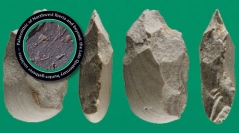

 Comptes Rendus Palevol
20 (1) - Pages 1-19
Comptes Rendus Palevol
20 (1) - Pages 1-19The Miño River is one of the main Atlantic basins of Iberia and preserves extensive Pleistocene deposits. However, there is presently limited information concerning the first human occupation history of this region. Existing research undertaken across the region has identified a significant number of Large Flake Acheulean (LFA) sites with African affinities. These sites are associated with former fluvial environments and are now preserved as a sequence of fluvial terraces along the Miño River, located between relative elevations of + 40 m and + 20 m, and dated to between Marine Isotope Stages (MIS) 9 and 6. The chronological range and observed technological patterns are similar to those recognised in other areas of South western Europe, particularly the central Iberian Peninsula and Aquitanian region (France) during the second half of the Middle Pleistocene.
Lower palaeolithic, acheulean, Iberian Peninsula, Middle pleistocene, Miño River, fluvial terraces